Nutrition in Animals
NCERT Class 7 Science Chapter-2-Notes,Solutions,Video,Tests, PDF
Theory
Topics to be learn :
- DIFFERENT WAYS OF TAKING FOOD
- DIGESTION IN HUMANS
- DIGESTION IN GRASS-EATING ANIMALS
- FEEDING AND DIGESTION IN AMOEBA
[responsivevoice voice="UK English Female" rate="0.8" pitch="0.8" buttontext="Listen to this"]
Different ways of taking the food:
| Name of Animals | Kind of Food | Mode of Feeding |
| Humming Bird | Nectar | Sucking |
| Human Beings | Fruits, Vegetables | Mouth (Chewing and Swallowing) |
| Snakes | Rats | Swallowing |
| Frogs | Insects | Swallowing (Sticky Tongue) |
| Earthworm | Decaying Matter | Swallowing (Muscular Pharynx) |
| Spiders | Insects | Grinding |
| Amoeba | Tiny Food Particles | Engulfing (Pseudopodia) |
| Hydra | Insects and Fish | Tentacles |
| Bees | Nectar | Sucking |
| Snail | Grass | Chewing |
| Ants | Insects | Scraping |
| Housefly | Decaying Matter | Brewing |
| Lice | Blood | Sucking |
| Butterfly | Nectar | Sucking |
Thus, we can see that different organisms have different modes of nutrition.
Few organisms have a well-developed digestive system to digest their food. The lower organisms do not have proper digestive organs.
The food is broken down into smaller particles and transported to various parts of the body. The waste products are eliminated through the excretory organs in the body.
[/responsivevoice]
[responsivevoice voice="UK English Female" rate="0.8" pitch="0.8" buttontext="Listen to this"]
Digestion in Humans :
- The food that we eat passes through a Canal inside our body.
- The food is processed and utilized in the body and unused food is collected inside the canal only.
- This Canal is often called as the Alimentary Canalor the Digestive Tract.
The canal is divided into different parts:
- The Mouth or Buccal Cavity
- Food Pipe or Oesophagus
- Stomach
- Small Intestine
- Large Intestine
- Anus
There are three glands associated with the alimentary canal that secrete digestive juices that are used to convert the complex food substances into simpler substances.
- liver
- pancreas
- salivary glands
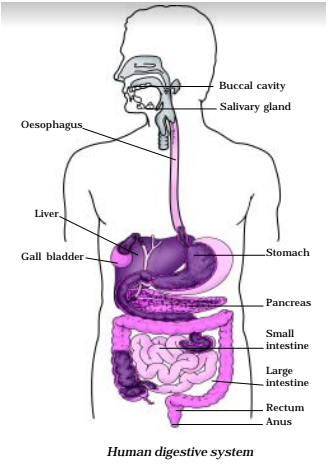
The Digestive System - The alimentary canal and the digestive glands together form a system in the human body which is responsible for the digestion of food in the body. This system is called the Digestive System.
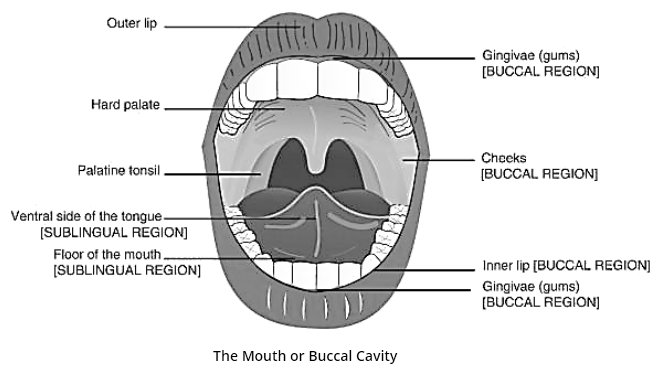
- Ingestion- the process of taking in the food through the mouth is called ingestion.
- The food is chewed with the help of teeth, saliva and the tongue present in the mouth.
- The salivary glands present in our mouth secrete saliva which mixes with the food, moist it and breaks the starch present in the food into sugar.
- The tongue present in the mouth helps in mixing the food with the saliva and helps in swallowing it inside the mouth. It also has taste buds which help in identifying the taste of anything that we eat. Besides this, the tongue also helps in talking. [/responsivevoice]
[responsivevoice voice="UK English Female" rate="0.8" pitch="0.8" buttontext="Listen to this"]
The Teeth :
Milk Teeth - In the early childhood a set of teeth growth in children that then fall off after certain age 6 to 8 years. These teeth are called Milk Teeth.
Permanent Teeth - The teeth that grow after milk teeth fall off are called Permanent Teeth. They generally remain during the lifetime of a person or at least until old age.
Different Types of Teeth :
- Incisor – to cut food like a pair of scissors.
- Canine – to tear food like a fork.
- First molars– can grind food.
- Second molar – larger than first molars, can grind food like first molars
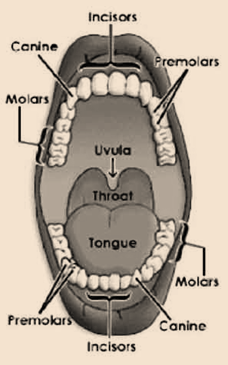
Tooth Decay –
- A gradual damage of teeth is often called tooth decay.
- The main cause of tooth decay is the presence of bacteria in the mouth that grow if we do not keep our mouth and teeth clean.
- Any leftover food present inside our teeth is broken down by such bacteria.
- As a result, an acid is released which damages the teeth slowly.
- Tooth decay can cause severe pain and even toothless.
- Tooth decay is caused mainly because of eating food with high sugar content, soft drinks and chocolates.

How can we prevent tooth decay?
- Clean your teeth with a brush or dental floss at least twice a day
- Rinse your mouth after every meal you eat
- Do not put a dirty finger or any unwashed food items in your mouth
Food Pipe or Oesophagus
- The food pipe starts from the neck region and runs until the chest area in animals.
- The food, when the chewed, moves through the food pipe and reach the stomach through this path.
- The food moves in download direction in the food pipe. [/responsivevoice]
[responsivevoice voice="UK English Female" rate="0.8" pitch="0.8" buttontext="Listen to this"]
The Stomach :
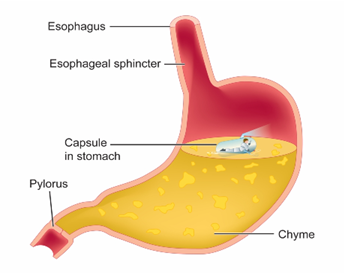
- It is the widest part of the alimentary canal.
- It's a bag like structure in a flat U shape.
- The stomach is connected with the food pipe and the small intestine.
- The stomach’s inner lining produces three things:
- Mucous: It protects the stomach lining.
- Hydrochloric Acid: It kills the bacteria present inside the stomach and activates the digestive juices.
- Digestive Juices: They help in digestion of the food by breaking down the proteins present in the food into simple substances.
Small Intestine :
- It is a highly coiled structure.
- The length of the small intestine is almost 7.5m.
- The liver and pancreas release digestive juices into the small intestine.
- The inner lining of the intestine also secretes some digestive juices on its own.
- The small intestine breaks the carbohydrates into glucose, fats into fatty acids and proteins into amino acids.
The Liver :
- It is a gland reddish brown in colour.
- It is known as the largest gland of the human body.
- It secretes a digestive juice called bile juice.
- The bile juice is stored in the gallbladder.
- The bile juice makes it possible for the body to digest the fats.
The Pancreas :
- It is a cream coloured gland present in the human body.
- It secretes pancreatic juice that helps in digestion of fats, carbohydrates and proteins.
How small intestine absorbs food?
- Absorption: it is a process by which the digested food enters the blood vessels of the small intestine.
- Villi in the intestine: the small intestine contains small finger-like structures called Villi. They increase the surface area of the intestine thereby increasing the amount of absorption. The digested food gets into the blood vessels through villi and then reaches the whole body.
- Assimilation: The process by which the organs of the body utilize the digested food and form complex substances which the body needs such as proteins are called Assimilation.
Parts of Small Intestine :
The small intestine has been divided into three parts:
- Duodenum : It is the first part of the small intestine whose main function is to initiate the digestive process. In this process, the food that enters the small intestine from the stomach is mixed with the digestive juices (bile and pancreatic juice) and is further broken down into simpler substances.
- Jejunum : It is the middle part of the small intestine that contains the villi and hence undergoes absorption and assimilation.
- Ileum : It is the third and last part of the small intestine that contains villi-like structures. The ileum absorbs vitamin B12, bile acids and any other nutrients present in the food.
The Large Intestine :
- Any food that is left undigested passes through the small intestine and enters the large intestine.
- It is a wide tube-like structure.
- It is only 1.5 m long.
- The main function of the large intestine is to absorb water and salts from the undigested food.
- The rest of the waste, undigested food passes through the rectum.
- Egestion: The process by which the waste, undigested food (the faecal matter) get out of the body through the anus.
What is diarrhoea?
- A condition when watery stools appear frequently is called Diarrhoea.
- Food poisoning and infection are two main causes of diarrhoea.
- It is a serious disease and can lead to death in severe cases because it involves extensive loss of water and salts from the body.
- Generally, ORS (Oral Rehydration Solution) which is boiled cooled water in which a pinch of salt or sugar is added is recommended to the patients to maintain the water loss of the body. [/responsivevoice]
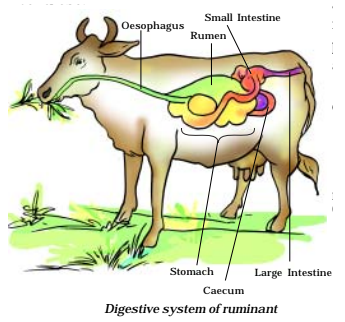
[responsivevoice voice="UK English Female" rate="0.8" pitch="0.8" buttontext="Listen to this"]
- Rumen- It is a sac-like structure present between the food pipe and the small intestine in grass eating animals like cows and buffaloes.
- At first, the animals do not chew their food (basically grass) and instead swallow it.
- This partly digested food is stored in the rumen.
- Cud:The partly digested food present in the rumen is called Cud.
- Rumination: The cud returns to the mouth in these animals and then they chew it. This is called Rumination.
- Ruminants: the animals that swallow their food at first and then chew it, later on, are called Ruminants.
Grass eating animals can digest cellulose while several other animals cannot. These animals have a different type of bacteria present in the stomach that helps in digesting the cellulose. [/responsivevoice]
[responsivevoice voice="UK English Female" rate="0.8" pitch="0.8" buttontext="Listen to this"]
Feeding and Digestion in Amoeba :
Amoeba is a simple, unicellular organism which is found at the bottom of fresh water, It contains jelly-like cytoplasm with a clear nucleus, many food vacuoles, and contractile vacuoles. Because amoeba is unicellular, It means a single cell performs all the function like digestion, respiration, reproduction etc.
- The Amoeba is a microscopic organism which is made up of only one cell.
- The Amoeba has a cell membrane, cytoplasm, a nucleus which is round and dense and small vacuoles which are like bubbles present all over it.
- The Amoeba is capable of changing its shape and position on its own.
- It uses false teeth called pseudopodia to take in the food present in the surroundings.
- Whenever it wants to intake the food the pseudopodiaor finger-like projections come out of its body.
- The pseudopodia engulf the food in and the food gets stored in the food vacuoles.
- Then it secretes some digestive juices inside the vacuoles that help in its digestion of the food.
- The Amoeba then absorbs the digested food and uses it for fulfilling different life processes such as multiplication and growth.
- The Amoeba also secretes out waste products or undigested food out of its body.
Digestion Process in Amoeba :
Digestion in amoeba is intracellular taking place within the cell. The food taken in remains in a food vacuole or gastric vacuole formed by the cell membrane and small part of the cytoplasm. The vacuoles are transported deeper into the cells by cytoplasmic movements. Here they fuse with lysosomes that contain enzymes. Two enzymes amylase and proteinase have been reported. Thus, amoeba can digest sugars, cellulose and proteins. Fats, however, remain undigested.
The contents of the vacuole become lighter and the outline of the vacuole becomes indefinite indicating that the digestion is complete.
Absorption :
Since the food on digestion is converted into liquid diffusible form, it is readily absorbed by the cytoplasm. The vacuole becomes progressively smaller as the food is absorbed by diffusion.
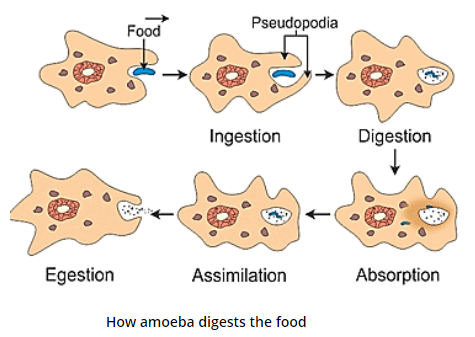
Assimilation :
All the parts of the cell get the nutrients by the cyclic movement of the cytoplasm called the cyclosis. These nutrients are used to build new protoplasm. In this manner the food is assimilated.
Egestion :
The egestion takes place by exocytosis. There is no particular point from which the egestion takes place. As the amoeba moves forward, the undigested matter is shifted to the back and eliminated as food pellets through a temporary opening formed at any nearest point on the plasmalemma. [/responsivevoice]
[responsivevoice voice="UK English Female" rate="0.8" pitch="0.8" buttontext="Listen to this"]
Quick Revision :
- The animals depend upon other plants and animals for their food.
- Animal nutrition comprises the mode of taking in the food in the body, nutritional requirements of the body and how animals can utilize their food.
- Digestion- it is a process by which animals break down complex food substances in simpler substances.
- Animal nutrition includes nutrient requirement, mode of intake of food and its utilisation in the body.
- The human digestive system consists of the alimentary canal and secretory glands. It consists of the (i) buccal cavity, (ii) oesophagus, (iii) stomach, (iv) small intestine, (v) large intestine ending in rectum and (vi) anus.
- The main digestive glands which secrete digestive juices are (i) the salivary glands, (ii) the liver and (iii) the pancreas. The stomach wall and the wall of the small intestine also secrete digestive juices.
- The modes of feeding vary in different organisms.
- Nutrition is a complex process involving: (i) ingestion, (ii) digestion, (iii) absorption, (iv) assimilation and (v) egestion.
- Digestion of carbohydrates, like starch, begins in the buccal cavity. The digestion of protein starts in the stomach. The bile secreted from the liver, the pancreatic juice from the pancreas and the digestive juice from the intestinal wall complete the digestion of all components of food in the small intestine. The digested food is absorbed in the blood vessels from the small intestine.
- The absorbed substances are transported to different parts of the body. Water and some salts are absorbed from the undigested food in the large intestine.
- The undigested and unabsorbed residues are expelled out of the body as faeces through the anus.
- The grazing animals like cows, buffaloes and deer are known as ruminants. They quickly ingest, swallow their leafy food and store it in the rumen. Later, the food returns to the mouth and the animal chews it peacefully.
- Amoeba ingests its food with the help of its false feet or pseudopodia. The food is digested in the food vacuole. [/responsivevoice]
NCERT Class-7-Science-Chapter-2-Nutrition in Animals-Solution
Question 1:
Fill in the blanks:
(a) The main steps of nutrition in humans are __________, __________, ___________, __________ and ________
(b) The largest gland in the human body is __________.
(c) The stomach releases hydrochloric acid and ________ juices which act on food.
(d) The inner wall of the small intestine has many finger-like outgrowths called __________.
(e) Amoeba digests its food in the __________.
(a) The main steps of nutrition in humans are ingestion, digestion, absorption, assimilatio and egestion (b) The largest gland in the human body is liver. (c) The stomach releases hydrochloric acid and digestive juices which act on food. (d) The inner wall of the small intestine has many finger-like outgrowths called villi. (e) Amoeba digests its food in the food vacuol.
Question 2:
Mark ‘T’ if the statement is true and ‘F’ if it is false:
(a) Digestion of starch starts in the stomach. (T/F)
(b) The tongue helps in mixing food with saliva. (T/F)
(c) The gall bladder temporarily stores bile. (T/F)
(d) The ruminants bring back swallowed grass into their mouth and chew it for some time. (T/F)
(a) Digestion of starch starts in the stomach. (F) (b) The tongue helps in mixing food with saliva. (T) (c) The gall bladder temporarily stores bile. (T) (d) The ruminants bring back swallowed grass into their mouth and chew it for some time. (T)
Question 3:
Tick ( √) mark the correct answer in each of the following:
(a) Fat is completely digested in the
(i) stomach (ii) mouth (iii) small intestine (iv) large intestine
(b) Water from the undigested food is absorbed mainly in the
(i) stomach (ii) food pipe (iii) small intestine (iv) large intestine
(a) Fat is completely digested in the (iii) small intestine √ (b) Water from the undigested food is absorbed mainly in the (iv) large intestine √
Question 4:
Match the items of Column I with those given in Column II:
| Column I | Column II |
| Food components | Product(s) of digestion |
| Carbohydrates | Fatty acids and glycerol |
| Proteins | Sugar |
| Fats | Amino acids |
Column I
Column II
Food components
Product(s) of digestion
Carbohydrates
Sugar
Proteins
Amino acids
Fats
Fatty acids and glycerol
Question 5:
What are villi? What is their location and function?
Villi are tiny finger-like projections originating from the walls of the small intestine. They increase the surface area for absorption of the digested food. The blood vessels present inside the villi can absorb the nutrients from the digested food.
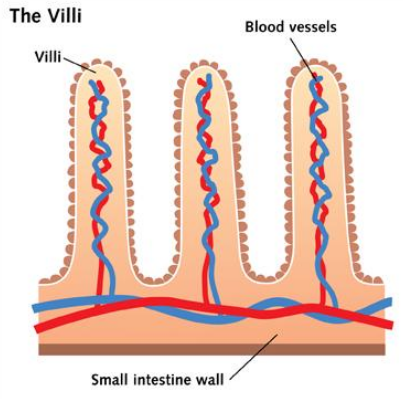
Question 6:
Where is the bile produced? Which component of the food does it help to digest?
Bile is produced by liver and is stored temporarily in gall bladder.Bile juice mainly digests fat.
Question 7:
Name the type of carbohydrate that can be digested by ruminants but not by humans. Give the reason also.
Cellulose the carbohydrate that can be digested by ruminantsand not by the human beings. The enzyme required to breakdown cellulose is produced only in the ruminants and not human beings. So, humans cannot digest that.
Question 8:
Why do we get instant energy from glucose?
Glucose is a simple sugar. Carbohydrates, when consumed, have to be digested into glucose. As glucose can be easily absorbed in blood, it provides energy to the body. Hence, when glucose is directly taken, it does not have to be digested and thus acts as an instant source of energy.
Question 9:
Which part of the digestive canal is involved in:
(i) absorption of food ____.
(ii) chewing of food ____.
(iii) killing of bacteria ____.
(iv) complete digestion of food ____.
(v) formation of faeces ____.
(i) Absorption of food small intestine (ii) Chewing of food buccal cavity (iii) Killing of bacteria stomach (iv) Complete digestion of food small intestine (v) Formation of feces large intestine
Question 10:
Write one similarity and one difference between the nutrition in Amoeba and human beings.
Similarity between nutrition in Amoeba and human beings: Both Amoeba and humans require energy for the growth and maintenance of their bodies. This energy is derived from the food that they eat. The food that they consume is always in a complex form and is therefore broken down into simpler forms by the process of digestion. Hence, both these organisms are heterotrophs. Differences between nutrition in Amoeba and human beings:
Digestion in Humans
Digestion in Amoeba
(i)
Humans have a mouth and a complex digestive system.
(i)
Mouth and digestive system are absent in Amoeba.
(ii)
Digestive juices are secreted in the buccal cavity, stomach, and small intestine.
(ii)
Digestive juices are secreted in the food vacuole.
(iii)
Digestion of carbohydrates, proteins, and fats starts in separate regions.
(iii)
All the food components are digested in the food vacuole.
Question 11:
Match the items of Column I with suitable items in Column II
| Column I | Column II | ||
| (a) | Salivary gland | (i) | Bile juice secretion |
| (b) | Stomach | (ii) | Storage of undigested food |
| (c) | Liver | (iii) | Saliva secretion |
| (d) | Rectum | (iv) | Acid release |
| (e) | Small intestine | (v) | Digestion is completed |
| (f) | Large intestine | (vi) | Absorption of water |
| - | - | (vii) | Release of faeces |
Column I
Column II
(a)
Salivary gland
(iii)
Saliva secretion
(b)
Stomach
(iv)
Acid release
(c)
Liver
(i)
Bile juice secretion
(d)
Rectum
(ii)
Storage of undigested food
(e)
Small intestine
(v)
Digestion is completed
(f)
Large intestine
(vi)
Absorption of water
Question 12:
Label Fig. 2.11 of the digestive system.
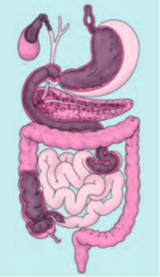
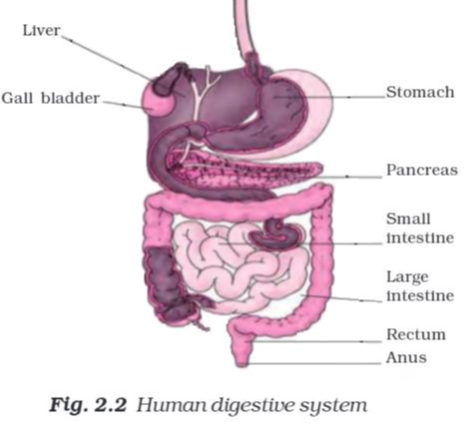
Question 13:
Can we survive only on raw, leafy vegetables/grass? Discuss.
No, we cannot survive only on raw, leafy vegetables/grass, because to live a healthy life we should have a balanced diet with all then nutrients. Raw vegetables and grasses only provide with fibers which is not enough for the body. So, these green leafy vegetables will not serve the purpose.
Video
Click on below link to open video
1- [video_lightbox_youtube video_id="y_dK9lUVVbI&rel=0" width="640" height="520" start="10" anchor="Introduction"]
2- [video_lightbox_youtube video_id="MdSjoKB9IbU&rel=0" width="640" height="520" start="10" anchor="Mouth and Buccal Cavity"]
3- [video_lightbox_youtube video_id="Lzu5PffUNSQ&rel=0" width="640" height="520" start="10" anchor="Different Types of Teeth"]
4- [video_lightbox_youtube video_id="wHpiWH6jW_c&rel=0" width="640" height="520" start="10" anchor="Feeding and Digestion in Amoeba"]
5- [video_lightbox_youtube video_id="e3FahyXIcQk&rel=0" width="640" height="520" start="10" anchor="Digestion in Grass Eating Animals"]
6- [video_lightbox_youtube video_id="VntaoY0RA4o&rel=0" width="640" height="520" start="10" anchor="Q 1 & Q 2 :- Chapter 2"]
7- [video_lightbox_youtube video_id="DRIb-P4OzJk&rel=0" width="640" height="520" start="10" anchor="Q 3 & Q 4 :- Chapter 2"]
8- [video_lightbox_youtube video_id="eAZD876QTrE&rel=0" width="640" height="520" start="10" anchor="Q 5 & Q 6 :- Chapter 2"]
9- [video_lightbox_youtube video_id="IwEGJcuKGEU&rel=0" width="640" height="520" start="10" anchor="Q 7 & Q 8 :- Chapter 2"]
10- [video_lightbox_youtube video_id="g1kP9L0CsVk&rel=0" width="640" height="520" start="10" anchor="Q 9 & Q 10 :- Chapter 2"]
11- [video_lightbox_youtube video_id="UHb-aQViJm0&rel=0" width="640" height="520" start="10" anchor="Q 11 & Q 12 :- Chapter 2"]
Click on below link to View and Download
NCERT- Class 7-Science Chapter 2 Notes PDF